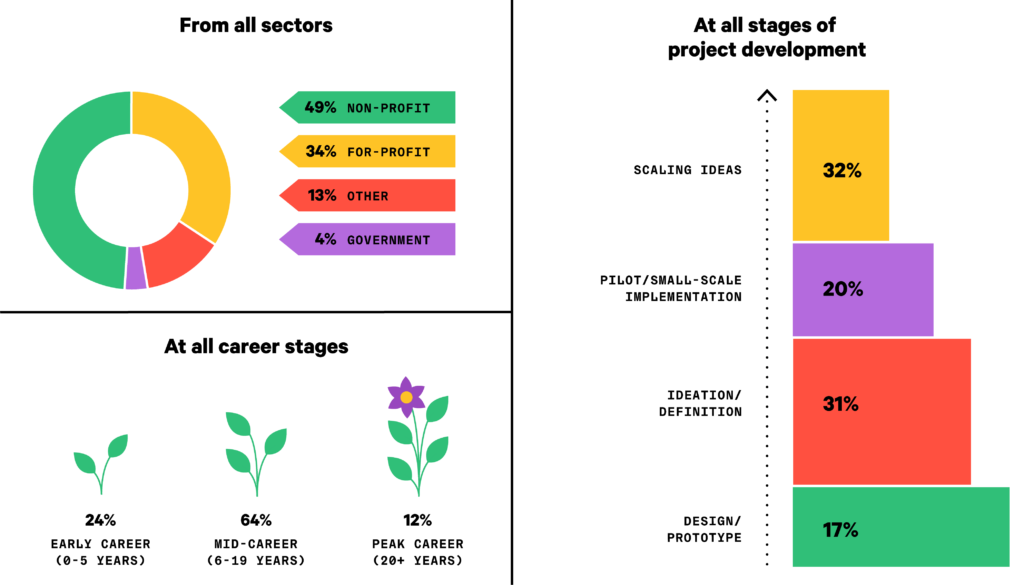About one year ago, the Center for Social Impact Strategy began the process of redesigning our look and updating our website. What follows is an interview with the individuals that led the design process: Kaveh Sadeghian, Creative Director and Founding Member of CSIS, and L+L, a Brooklyn-based, multidisciplinary design studio, led by Liz Turow and Leigh Mignogna, that works closely with organizations in mission-driven, arts and cultural spaces.
Behind CSIS’ Updated Look
How did the idea to give CSIS a new look come about and what was the intention behind it?
Kaveh Sadeghian (KS): I think CSIS over the last five years has grown and matured. For me, it was a matter of updating the brand to align with the community and the global stage that the Center is operating on. It was also about making a brand that was approachable and that overtly celebrated diversity and connection, which is how the Center operates.
Liz + Leigh (L+L): At the time their original website was built, the Center as an organization looked pretty different. They started out with a handful of programs that had since evolved—some programs were no longer offered while some continued to gain in popularity, and they were looking at new partnerships and opportunities on the horizon. In many ways, they had simply outgrown their first website. When they approached us about a redesign, they knew that their website needed to accommodate more structural flexibility in order to better communicate their programming to students and peers. As our discussions continued, it became clear that it was not just written content, but also the visual look and feel of the Center that no longer reflected who they had become in the five years since they began.
What are some of the ways in which you sought to optimize the website?
L+L: The biggest addition with the new site is a section we call Independent Learning. Over years of programs and workshops, CSIS had developed an impressive archive of learning tools and frameworks that had been continually tested and refined. In addition, they had a wealth of really interesting content, for example, case studies documentaries about social impact work their alumni had undertaken. They wanted an online repository for all this collective intelligence that everyone—not just enrolled students and academics—could access from anywhere in the world. Our solution is an online archive that can accommodate different types of content and is tailored to the specialized work they do, from free framework tools to case studies of alumni work to graduate student research.
Describe the creative process. How did the design ideas evolve and what were the important elements to creating it?
KS: We looked back and we thought about actual memories that we had. When we are at a residential program, we look up and we see the stars and constellations. That’s a motif that is throughout a lot of the website. We looked back at a time that we were at an Impact House and we were there during peak firefly season, and it was the most number of fireflies I’ve ever seen, so that’s a motif. We thought about Peter [Frumkin, Faculty Director of the Center for Social Impact Strategy]— often times he takes folks out on a boat and does his office hours there, so he’s in one of the graphics on a fishing boat. We wanted our graphics to demonstrate the essence of all of the connections that are made and the personal development that’s done. Some of it is literal and some of it is figurative, but we drew a lot of inspiration from these really magical moments we’ve experienced in the last five years.
L+L: There was a lot about the aesthetic of the original website that felt appropriate to the Center, such as bright colors and great photography that showcased the CSIS community. But we also felt that we had an opportunity to breathe new life into the website by being selective about color and leaning on illustrations as well as photos to tell their story. When you’re talking about values like community, empathy, and self-awareness, there aren’t obvious visuals that come to mind. We sought to develop a unique illustration style that employs metaphor and atmosphere to convey abstract concepts. We worked hard with the team to come up with visuals that felt uniquely “theirs.”
Walk me through the design process. What steps did you take?
L+L: As we do with any large website project like this, we started by asking a lot of questions about the organization and how it defines itself. We talked at length about messaging—how they talk about the often complex and abstract work they do, and how those who intersect with them understand that work. When you live and breathe the work you do, as CSIS does with social impact strategy work, it’s often difficult to put it into words for someone who doesn’t share the same vocabulary. Since we knew nothing about it to start with, we had a lot of questions! Those conversations were really helpful in terms of laying a foundation for the story we wanted to tell. We also talked about who the audience would be—not just current and prospective students, but also a global community of people interested in this work. Next we took a bird’s-eye view of everything the Center has to offer. How might we organize all of these activities in a way that makes sense to a non-expert? How can we offer an understanding of the big picture, while also helping users navigate to the thing that interests them in particular? This part of a website design process—establishing information architecture and wireframing each type of page—is actually the hardest and takes time to get right!
What impact do you hope the color scheme will have on visitors to the website?
KS: I know for me, color has always been a central part of the CSIS brand. We intentionally used very bold colors because I think our work requires a certain level of boldness and brightness. You need to be bright, and you need to stay bright, and you need to remain positive to be able to do this work. We actually brightened up a lot of the colors from our original logo and made it more aligned with jewel tones, so they’re even more bold. Which is one thing I love about the color scheme and how we’ve gone about that. And we’re playing around a lot more with layering colors on top of each other in really interesting ways, which I think is something L+L drove us through. Before we would use color as a highlight or spotlight and really stick to one color at a time, but we’ve moved now into overlapping multiple colors in really interesting ways, which I think is more reflective of an interrelated, and intersectional, approach to social impact.
How are CSIS’s values emphasized?
KS: We just realized in these five years that people, both our students and our staff, gravitate a lot towards our values. Originally, we thought we should just write them in the booklets, just so people could know what they were. Then, we put them on large banners and we realized people really liked them and started taking pictures with them, so we put them on larger banners. People liked them even more and it became part of our set design. The values have sort of become this really interesting and, I think, unifying artifact within the Center. And it was unintentional. Although when you think about it, it’s not surprising because I think that sum up our motivators. It describes why we do what we do. And to a degree it describes our alumni community pretty effectively. So we spent a lot of time illustrating each of the values into some sort of visual with the hope that we would be able to do them a little bit more justice in terms of a larger brand and be able to highlight them more.
What do you hope the website conveys to visitors?
KS: I think the first thing I wish it would do is convey that the Center is optimistic and it believes in a better world. My hope is that the website helps folks find either community or content or confidence so that they can start doing the work that they want to be doing right away. And it can meet them wherever they are. I want the website to be able to meet all of those folks where they’re at. And have the unifying value be one about people who believe in a better world and want to do something about pursuing that vision today.
L+L: One of the best surprises in this whole process has been participating tangentially in the passion and enthusiasm that folks at CSIS effuse. They’re truly passionate about social impact work and the people they get to share it with. We hope that some of that pure, unabashed joy comes through in the design. Social impact strategy is serious work, but that doesn’t mean it’s not fun!







